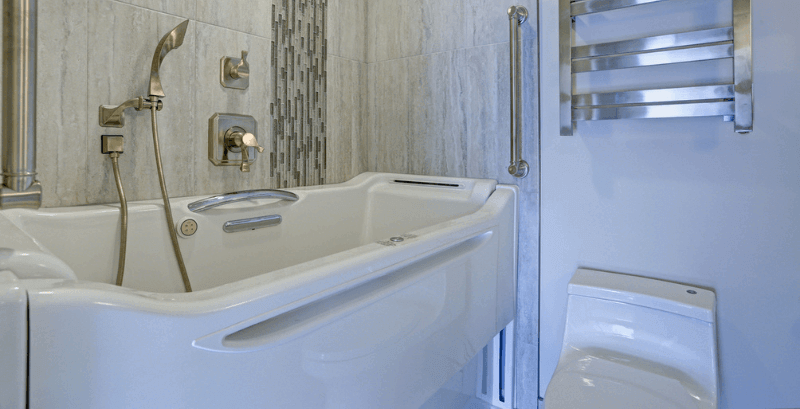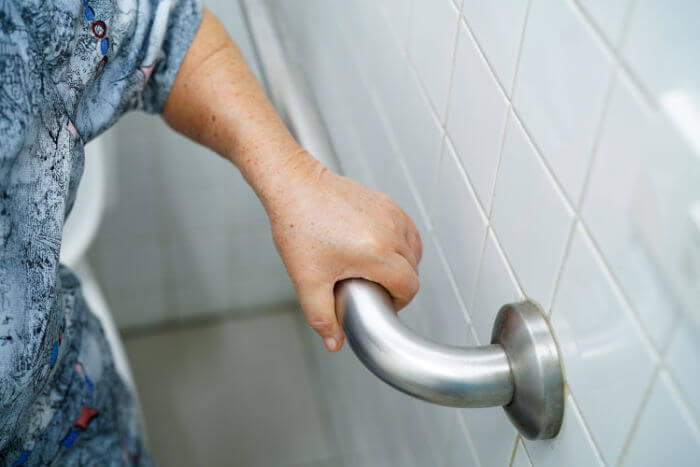Are you doing a bathroom remodel project?
Modernize can pair you with three to four pros in your area, so you can compare options and save time and money.
Bathroom Accessibility & Aging in Place
As time passes, more and more people find themselves considering how — and where — they want to live out their golden years. One trend that continues to be desirable is aging in place, or living in a “forever home” for as long as possible. This can give elderly homeowners more independence and comfort as they enter their older age. Aging in place often means reconfiguring a home with accessibility modifications, such as bathroom accessibility. Home accessibility improvements can allow people to adapt to natural bodily changes in the comfort of their own home.
Bathroom Accessibility Home Improvements
These modifications can vary from small tweaks to entire remodels, but many say they are worth it in the long run. In fact, a recent Modernize study showed that more than half of homeowners surveyed planned to explore home accessibility improvements within the next year.
The process of making a bathroom more accessible for those who want to age in place does not have to be a difficult one. Whether it is for yourself or a loved one, here is an overview of considerations to make when it comes to creating an accessible bathroom.
There are plenty of options to think about when it comes to bathroom accessibility modifications. Some choices are more involved, while others do not even require a contractor.
Walk-in Tubs

A more difficult but rewarding enhancement to make a bathroom more accessible is to replace an existing bathtub with a walk-in tub. Walk-in tubs are designed with a leak-proof door and a low threshold. This makes it easier to enter and exit safely. They can also be helpful if you live in a multi-generational household. Conversely, a simple consideration can include installing a grab bar in the bath, shower, and near the toilet for safer mobility. Explore the best walk-in tub brands to compare costs and top features.
Walk-in Showers
For those who prefer a shower over a bathtub, a walk-in shower is another bathroom accessibility feature to consider. These showers have no ledges taller than three inches, allowing elderly homeowners to easily enter the shower area without the worry of tripping or falling. In addition, most walk-in showers are equipped with non-slip flooring and even shower seating for a safe and comfortable shower experience.
More Accessible Bathroom Modifications

Find the Right Contractor for Your Bathroom Remodeling Project
Whether you’re ready to begin your project now or need some expert advice, our network of contractors are here to help. With a few simple questions, we’ll find the best local professionals for you
This matrix provides a look at some simple bathroom accessibility enhancements and their level of difficulty to install. Basic improvements are possible to DIY may not need a contractor’s assistance or permits. Minor and major improvements are more involved and likely require the work of a contractor.
| Accessibility Improvement | Difficulty Level |
|---|---|
| Install raised toilets or add an adjustable seat | Minor |
| Add a fold-down seat in the shower | Basic |
| Replace your tub with a walk-in tub | Major |
| Replace lightbulbs with a brighter option | Basic |
| Replace bathroom faucets with levered or motion-sensing models | Basic |
| Choose detachable and adjustable showerheads with at least a six-inch reach | Basic |
Be sure to also explore our home accessibility checklist for other home modifications to consider around your home for aging in place purposes.
What to Anticipate for an Accessible Bathroom Renovation
Remodeling a bathroom for home accessibility purposes can be an exciting moment toward making your aging in place goals a reality. Still, there are considerations to make before bathroom accessibility renovations are underway.
- Alternative Bathroom: Depending on the extent of your remodeling plans, an alternative bathroom may be necessary. For instance, if your home is multi-generational, you may want one accessible bathroom designated for your elderly loved ones versus younger loved ones.
- Water Access: It’s important to know if you will have access to water or not during remodeling. If water will be unavailable, be sure to make back-up plans for bathing, using the toilet, and washing up while the project is being completed.
- Budgeting: Consider your bathroom remodel budget ahead of time, including parts, labor costs and potential permitting expenses.
Planning with a Qualified Contractor
It’s important to find the right handicap accessible contractor when it comes to creating a bathroom space that is both functional and safe for you and your loved ones. These are projects that involve entrusting someone familiar with bathroom accessibility appliances and features.
Modernize can connect you with local contractors who have experience with bathroom accessibility remodeling and construction projects.
Let us guide you through what questions to ask and what you need to know about the bathroom accessibility process. Most importantly, we will help you find the contractor who can make it all come together to create an attractive, safer, and more accessible bathroom.
Find the Right Contractor for Your Bathroom Remodeling Project
Whether you’re ready to begin your project now or need some expert advice, our network of contractors are here to help. With a few simple questions, we’ll find the best local professionals for you
Reviews from Real Homeowners
Welcome to Homeowner Resources! We are the Modernize blog. Modernize pairs more than 3 million homeowners a year with pre-vetted contractors in their area. This blog started because we believe homeowners should know everything about their homes, from how their HVAC works to which front door colors they might love. On Homeowner Resources, you can find information on every part of your home, right down to how you can negotiate with contractors to get the best price. Here's more about the blog.
Need a contractor? Learn more about how Modernize finds the right pro for you.




